Tajikistan the “Water Gates” of Central Asia has a strong macro-economy which has already outperformed its regional countries despite regional weak economic prospects and global financial uncertainties in the recent times.
Sustained Socio-Economic Development
Despite many external challenges it achieved sustainable economic growth. During the last five years, it was driven mainly by foreign financed public and private investments due to which real GDP was expanded by a robust 6.9 percent.
Drastic Reduction in Absolute Poverty Rations
Since independence, Tajikistan initiated various short and long terms economic policies which has now reduced poverty. Between 2000 and early 2009, poverty decreased from 83 percent to about 47 percent which decreased further from 37 percent to 30.3 percent between 2012 and 2016. Since 2012, the poorest regions of the country have made the most progress in poverty reduction. At the same time, strong growth pushed down the poverty rate from 32 percent in 2015 to an estimated 30.3 percent by the third quarter of 2016, primarily driven by an increase in wage incomes. The expansion of the Targeted Social Assistance (TSA) program helped to reduce extreme poverty.
Expansionary Fiscal Policies
The government pursued expansionary fiscal policies in 2016-17, including through a considerable increase in foreign-financed capital investment in the energy sector, road infrastructure and related projects. The government also stimulated domestic demand by raising public sector wages and social transfers.
Supportive Monetary Policy
Monetary policy was supportive which generated a heightened demand for local currency as the exchange rate stabilized and wholesale transactions that were previously conducted in foreign currency switched to local currency. Moreover, domestic purchases of monetary gold and the introduction of a surrender requirement on ruble-denominated transfers achieved an increase in international reserves.
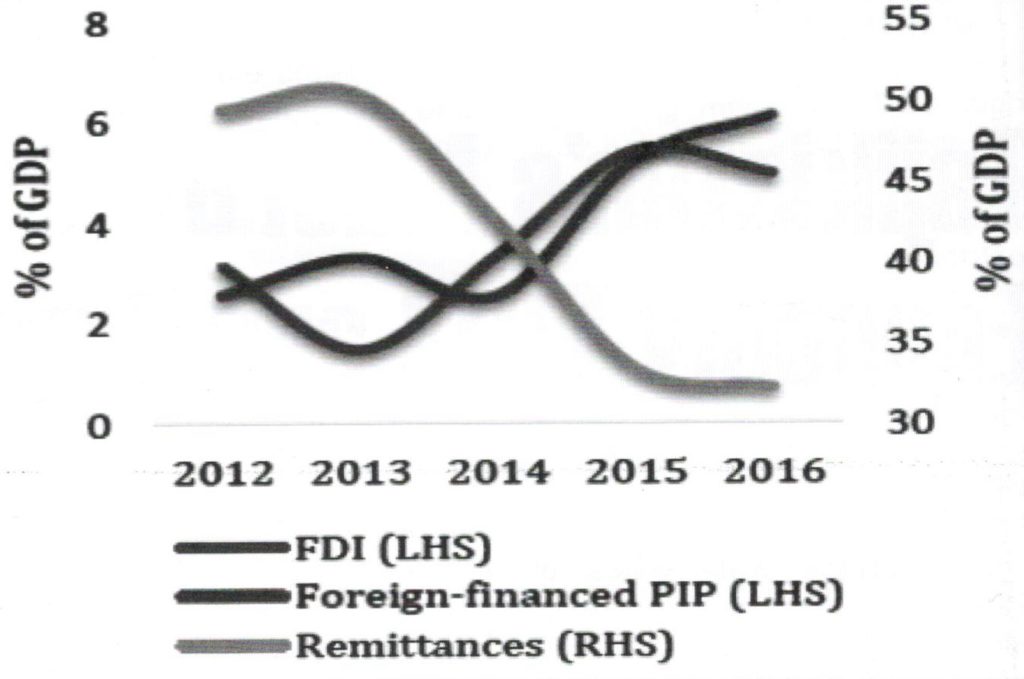
Sectorial Contribution in GDP %

Annual Real GDP
According to Tajikistan’s official figures, annual real GDP growth accelerated to 6.9 percent in 2016 from 6.0 percent in 2015. High levels of foreign financed public and private investment and an improvement in Tajikistan’s net export position more than compensated for a decline in consumption. It was achieved because of a decline in household consumption, which was largely affected by protracted currency depreciation in early 2016 and a further decline in migrant transfers by over 13 percent year on year in US dollar terms.
Economy of Supply
On the supply side, economic growth was developed by the construction and industry sectors which recorded annual growth rates of 20.3 percent and 16.0 percent respectively. Donor supported public investment in the rehabilitation of hydropower plants and road infrastructure achieved firm growth in the construction sector, while industrial output was supported by strong foreign direct investment [FDI] in coal and gold mining and processing as well as the food and textile industries.
Agricultural
The economic contribution of agriculture to GDP was modest in 2016, with annual growth of 5.2 percent largely reflecting enhanced efficiency gains and favorable weather conditions.
The above table clearly shows rapid upward growth in all the important sectors in its macro-economy during 2013-2016 wherein future economic prospects are strong and sustained.
Annual Consumer Price Inflation
Due to successful economic measures of the Tajikistan government, annual consumer price inflation was relatively stable in 2016, averaging 5.9 percent compared to 5.8 percent in 2015 Consumer Price Index (CPI). Government encouraged domestic savings and utilized it for increasing domestic investments mainly private investments.
External Economy
Better exports oriented policies and its facilitations paid dividends and Tajikistan’s external position improved in 2016 largely as a result of contraction of consumer imports. The current account deficit narrowed to 3.8 percent of GDP from 6.4 percent in 2015.
Inflows of FDIs
Foreign Direct Investments (FDIs) played a very important role in the improvement of macro-economy of Tajikistan. Inflows of FDI totaled 5 percent of GDP in 2016, down from 5.4 percent in 2015. The industries attracting the bulk of FDI in 2016 were mining and manufacturing. Around three-fourths of FDI inflows 74 percent.
Stable Exchange Rate
The government of Tajikistan successfully maintained a stable exchange rate mechanism and new surrender requirements introduced on ruble-denominated remittances facilitated an accumulation of official reserves in 2016. International reserves held by the National Bank of Tajikistan (NBT) increased by over 30 percent year on year in 2016, reaching 2.7 months of import cover.
Selected Economic Indicators
(In percentage)
| 2013 | 2014 | 2015 | 2016 | |
| Real GDP Growth | 7.4 | 6.7 | 6.0 | 6.9 |
| Agriculture | 2.0 | 1.1 | 0.9 | 1.3 |
| Construction | 1.6 | 3.0 | 2.5 | 2.7 |
| Industry | 0.6 | 0.8 | 1.6 | 2.3 |
| Services | 3.1 | 1.9 | 1.1 | 0.5 |
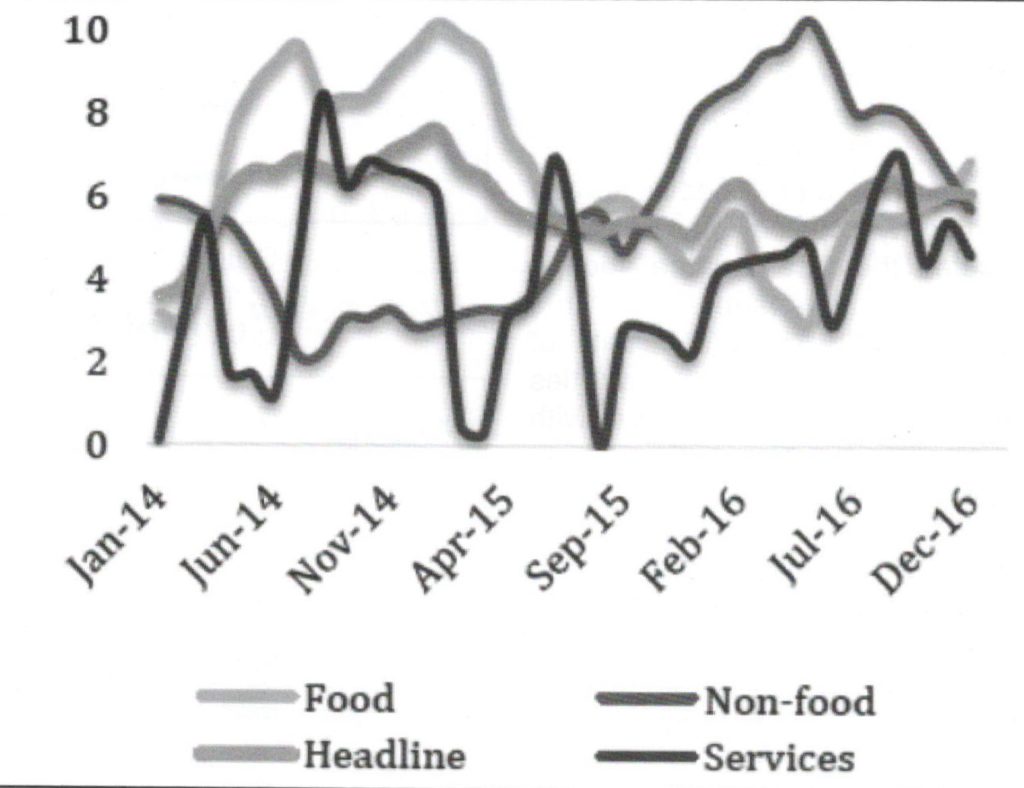
Unemployment Rate
Due to rapid social development the unemployment rate remained low in 2016, at 2.3 percent, and labor market pressure has been slowly easing as employment prospects improve in migrant destinations. The number of job vacancies reached 9,200 in December 2016, 26.5 percent higher than in the year earlier period.
Structural Reforms
Owing to rise of incidents of “national protectionism”, engulfed division between rich and poor countries/ people, unfavorable regional as well as global economic prospects, it is must to introduce meaningful series of “structural reforms”. The government of Tajikistan rightly introduced various structural reforms in all the important sectors of its economy and also announced “National Development Strategy 2030 which prioritizes energy sector as one of the strategic goals in its national’s economic development agenda.
Tajikistan identified the energy security and energy efficiency as one of its strategic objectives. It is now implementing 11 public investment projects amounting TJS 10bn in total to achieve this objective as well as develop and effectively use the huge energy resources of the country. Alongside with construction of new and rehabilitation of existing hydropower plants, it constructed the first and the second phases of Dushanbe-2 thermal power plant with the capacity of 400MW to supply various facilities and residents of Dushanbe with heating and address the power deficit in winter.
Current Account Developments
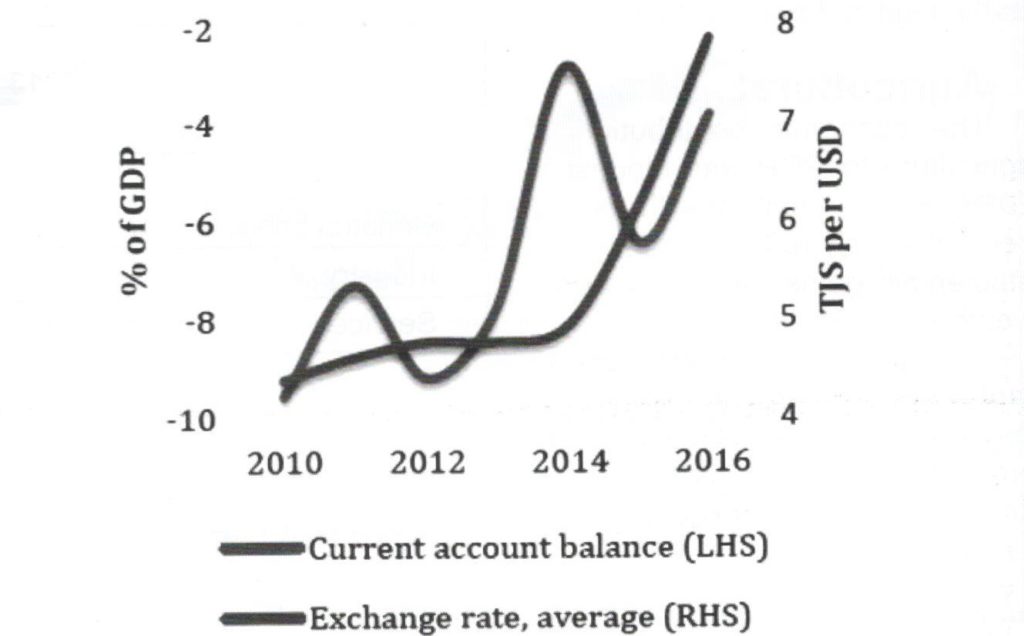
Current Account Developments
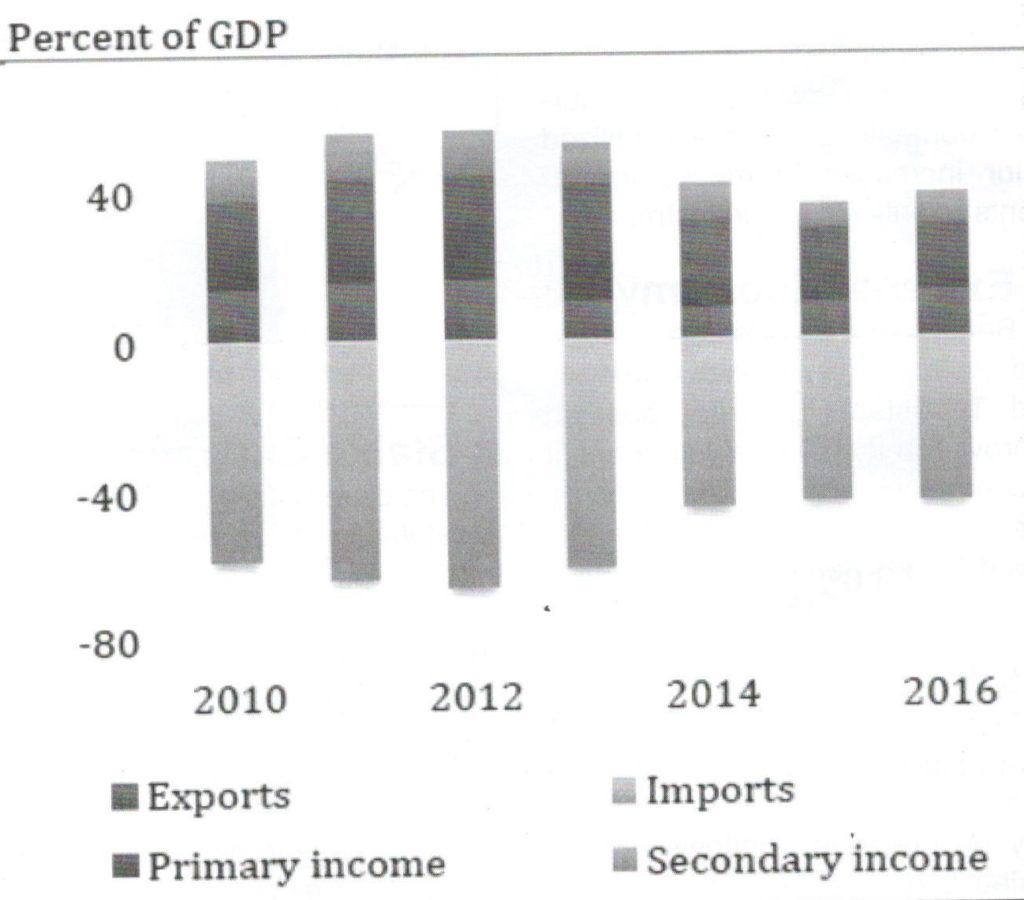
Better Business Climate & Foreign Investments
The Tajikistan government introduced and implemented various reforms in 2016 which improved its overall business climate and encouraged foreign investment. It streamlined the permitting system, business inspections and procedures for starting and operating a business. It introduced “electronic filing” of documents to obtain permits. It also introduced a new “Inspection Law” with a risk based approach for business inspections to ensure compliance in contrast to a previous focus on revealing inconsistencies and imposing fines. It established a “Coordination Council on Inspection”. Moreover, the government continued its efforts to simplify business registration procedures by integrating the information technology services of relevant agencies including the Tax Committee, TajStat and the State Insurance and Pension Fund into a one-stop-shop mechanism.
FDI Share
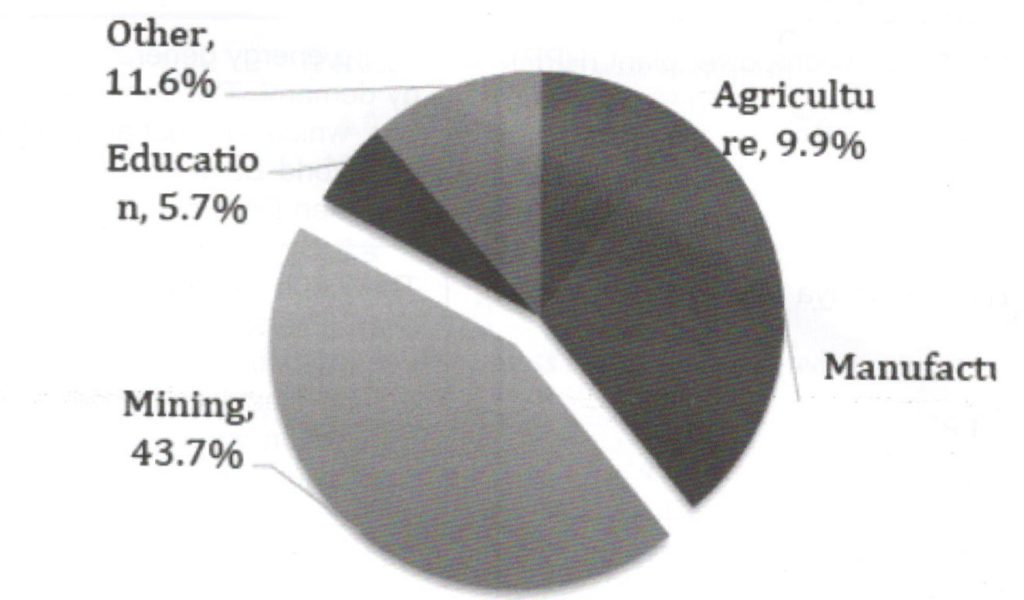
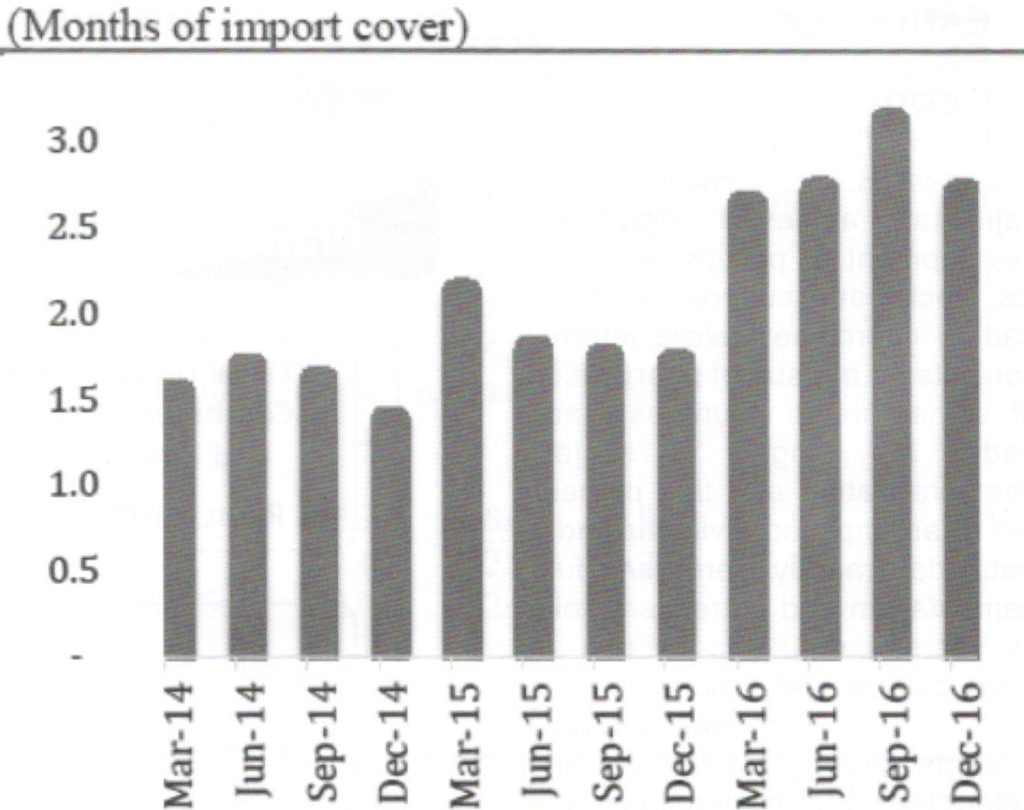
Simplification of Taxes
For attracting more and more inflows of FDIs and encouraging domestic investments in different sectors of the economy, the government established the “Appeal Council” which provided a platform for tax disputes, under the Tax Committee. Now tax laws are more people-, business- and investment-friendly. Taxes are lower and wider which has actually increased tax network in the country.
Public Financial Management Modernization Project (PFMMP-2)
The government also implemented the second phase of its Public Financial Management Modernization Project (PFMMP-2). The scope of the project was expanded to include public procurement, state audit and public administration reforms.
Prioritizing Primary Health
Since its inception, social development has remained as one of the key priorities of the government. The government adopted a resolution on per capita financing of primary health care service providers. The new framework, adopted in early 2016, envisages the more equitable allocation of funds for primary health care service providers based on the size of the population they serve.
Future Prospects
It is projected that Tajikistan’s real GDP growth rate would become more robust in the future and the financial sector would also be again productive and strong. Comprehensive reforms would bring desired goals of socio-economic during 2017-2019. Service sector would be in a comfortable zone in the short as well as long terms in the future. High inflows of FDIs would also be maintained and future increased. Further diversification of exports and rigorous commercial diplomacy would increase its current accounts. A prudent monetary policy stance and improved policy transmission mechanisms will support the objective of keeping inflation in single digits. An ideal combination of fiscal and monetary policies would improve the public sector outlook and would also ensure fiscal and debt sustainability.
| Mega Hydro Energy Projects & Capacity Buildings | Names & Utilities |
| The Nurek hydropower plant (HPP) | Hydro energy generates 70 percent of Tajikistan’s total annual energy demand. The financing for the first phase of the Nurek rehabilitation, which will cost an estimated US$350 million, was secured from the World Bank, the Asian Infrastructure Investment Bank and the Eurasian Development Bank. |
| The Golovnaya and Kairakum HPPs | The 3,600 megawatt (MW) Rogun HPP on the Vakhsh River, with the river diversion officially inaugurated by the President in October 2016. The first two units of the Rogun HPP are expected to start generating electricity by mid-2019. The government announced a TJS 530 million money issue in April 2017 to finance the construction of the Rogun HPP. |
| Commissioned the 400 MW Dushanbe-2 Combined Heat and Power Plant (CHPP) | Strengthened the power transmission network by constructing the North-South 500 kilovolt (kV) transmission line and rehabilitating major substations. |
Tajikistan’s Energy Initiatives

Estimated Projections (Selected Economic Indicators)
During the last 25 years, under President H.E. Emomali Rahmon Tajikistan achieved significant development in politics, economics, social and culture. Tajikistan had to overcome severe internal conflicts as a result of intervention of some foreign countries made under the slogan of society democratization and this process led to an imposed civil war and a fratricidal tragedy. Terrorism, fundamentalism and extremism voices got momentum to impose an alien culture and religion on the Tajik people which was defeated through a strong political will and determination of its people to fight against all odds. It took one decade to bring desired levels of peace and harmony in the country.
Now political chaos created by conspirators of the nation is over and now Tajikistan has achieved desired goals of political stability and sustainability of political system and of course maturity of democracy and its norms in the country.
The above table clearly shows constant upward growth would be expected in the macro-economy of Tajikistan during 2017-2019. There is an urgent need to expand financial sector of Tajikistan during this period. Further expansion of micro-financing would be useful for further development of SMEs and empowerment of women in the country.
Next Five Plan
During the next five years, the Tajik government plans to focus on the quality of human capacity building and pay attention to development of science, education, healthcare, culture, environment and employment. During this period, all adults will have at least secondary education and not less than half of able bodied population will have vocational or higher education. It is hoped that through its priorities Tajikistan’s government will achieve all it desired goals of socio-economic growth, sustainable economic development, massive industrialization, smarter/knowledge based economy and a greener environment in the near future. Institutionalization of vocational education will enhance levels of capacity buildings in the country.
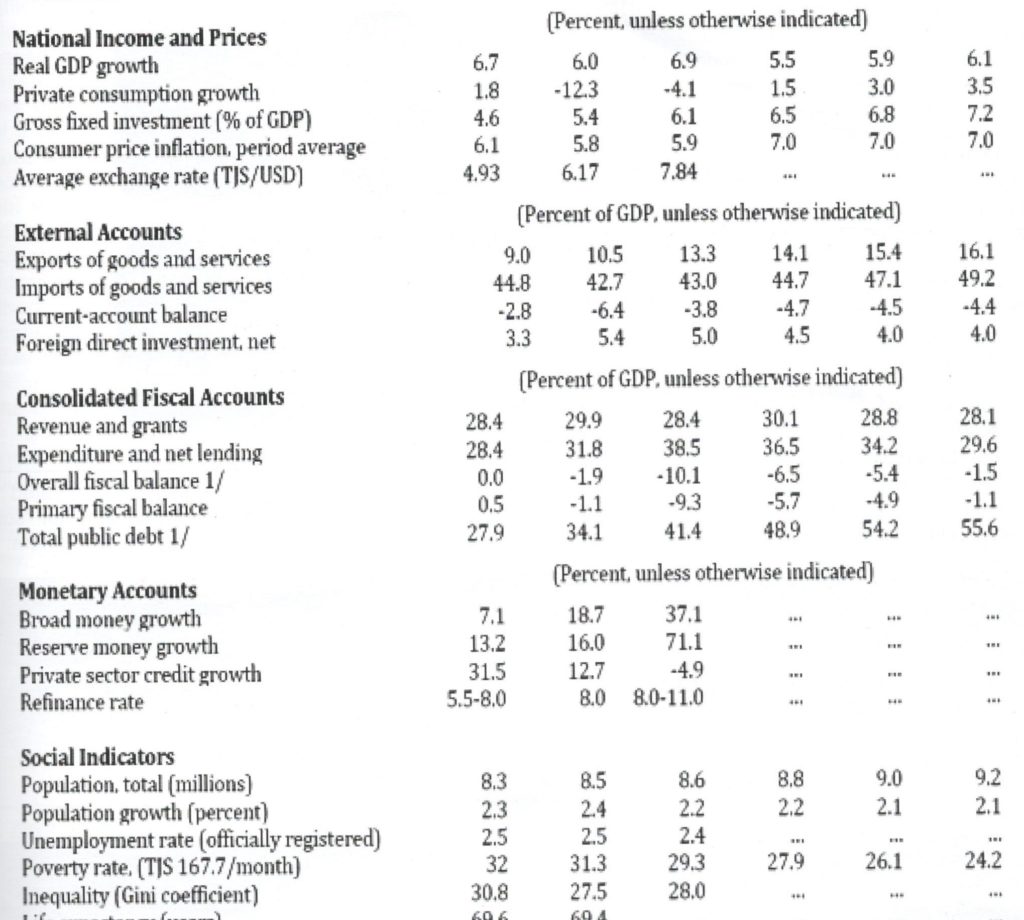
Tajikistan is a democratic country which is dominated by secularism. Its constitution guarantees civil rights and freedom and rule of law. It upholds social justice. Its parliament adopted a number of laws aimed at protection of human and civil rights and freedoms, ensuring law and order and development of economy and business.
The government of Tajikistan has undertaken certain policies/ programs to strengthen judicial independence based on the amendments made in the Constitution. It abolished the Council of Justice and handed over the issues pertaining to the selection and rotation of personnel as well as advanced professional training of judges to the Supreme Court and Supreme Economic Court.
Tajikistan has an open and pragmatic foreign policy which is balanced that ensured its deserved reputation in the international stage and established multifaceted relations and cooperation with the countries of the world, international and regional organizations and international financial institutions. It values commercial diplomacy. It is based on diplomacy, dialogue and development. It is a peace loving country which cares about other regional countries. It endorses all international treaties i.e. global partnership of human development, peace and harmony, discrimination etc.
Aim of Energy Sector Reforms

Series of Economic Reforms and Its Dividends
The President of the Republic of Tajikistan, H.E. Emomali Rahmon initiated various meaningful economic reforms in the country which has now improved investment climate. It supported the private sector. It created a favourable environment for sustainable economic development.
Since its early independence, Tajikistan implemented a series of national economic reforms which successfully transformed a planned economy into to a market-based economy and has undertaken various important steps in this direction, including adoption of a number of laws and regulations defining and regulating economic relations. It granted different forms of ownership, creation of various economic activities, privatization of public property, introduction of national currency, liberalization of pricing, establishment of joint ventures, ensuring free foreign trade and addressing priority social issues in the country.
Constant implementation of institutional reforms in important public sectors has now improved level of governance, finance, banking, real sectors of the economy, as well as education, health, and social security. The GDP per capita has increased by 19.6 times during the last 15 years alone (2000-2015).
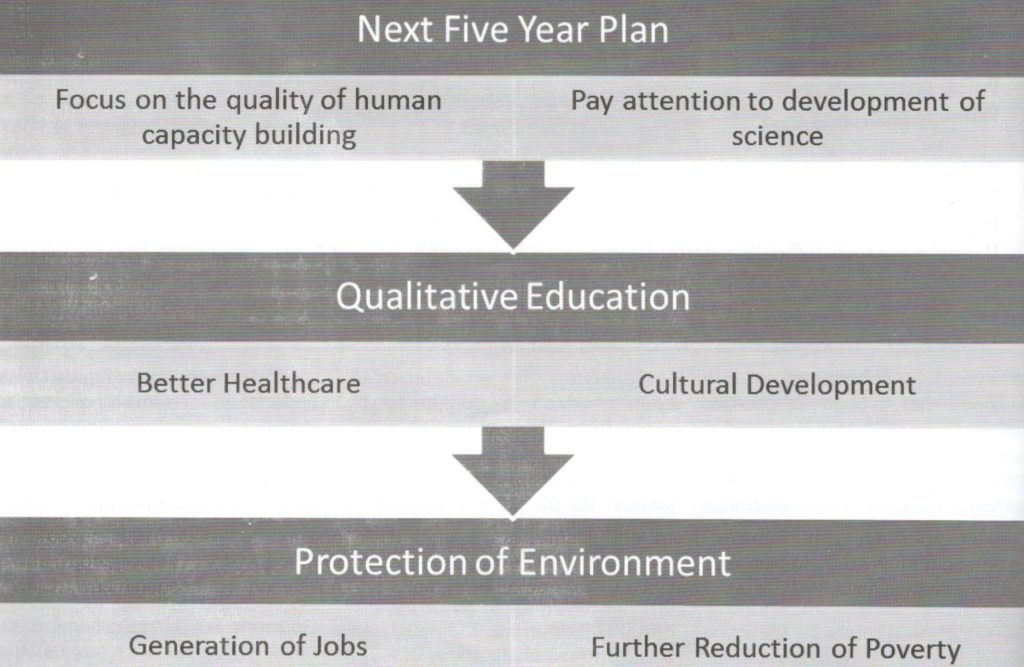
GDP per capita in 2000-2015
Due to series of economic reforms Tajikistan also enjoyed substantive growth of GDP since its inception. In this connection, the public budget revenue increased by 55.3 times compared to 2000.
Development of various sectors of the economy and improved living standards of the population made it possible to increase average monetary income of the population by 25.4 times during (2000-2015).
The foreign trade as another important indicator of the national economy development accounted for USD 131.1m only in 1991 and it increased by 33 times since inception.
Selected Macroeconomic Indicators (2009-2016)
| 2009 | 2010 | 2011 | 2012 | 2013 | 2014 | 2015 | 2016 | |
| GDP in nominal price, billion TJS | 20.6 | 24.7 | 30.1 | 36.2 | 40.5 | 45.6 | 48.4 | 54.5 |
| Growth rate % | 103.9 | 106.5 | 107.4 | 107.5 | 107.4 | 106.7 | 106.0 | 106.9 |
| Industrial output, billion TJS | 6.5 | 8.2 | 7.9 | 9.5 | 9.9 | 10.5 | 12.2 | 15.1 |
| Growth rate (%) | 93.6 | 109.2 | 105.7 | 110.8 | 103.8 | 105.0 | 111.3 | 116.0 |
| Agricultural output, billion TJS | 8.8 | 9.4 | 14.9 | 16.5 | 16.8 | 21.0 | 21.6 | 22.2 |
| Growth rate, % | 110.5 | 106.8 | 107.9 | 110.4 | 107.6 | 104.5 | 103.2 | 105.2 |
| Fixed Capital Investment, billion TJS | 3.9 | 4.7 | 5.0 | 4.5 | 5.8 | 7.5 | 9.7 | 11.1 |
| Inflation Rate, periodic, % | 5.0 | 9.8 | 9.3 | 6.4 | 3.7 | 7.4 | 5.1 | 6.1 |
| Unemployment rate, % | 2.2 | 2.1 | 2.3 | 2.4 | 2.3 | 2.4 | 2.3 | 2.4 |
| Public Budget Expenditures, billion TJS | 5.7 | 6.7 | 8.5 | 9.1 | 11.6 | 13.2 | 15.7 | 18.4 |
Tajikistan’s Strategic Objectives
Right from the beginning, the Tajik government defined its important strategic objectives, including energy security, food security and the country’s connectivity. A lot of activities have been undertaken to achieve these objectives. In order to achieve affordable and clean electricity, a number of economic and structural reforms have been implemented in the framework of strategic documents, including the Republic of Tajikistan Energy Development Concept to 2015 through establishment of a number of industrial and fuel and energy complexes as well as construction of small and large hydropower plants.
To ensure food security, a number of measures such as granting farmers the freedom of crop choice, supply of population and enterprises with raw materials, and creating jobs in the agricultural sector have been implemented which gave a new impetus to improve the country’s export potential.
Aims of Foreign Policy
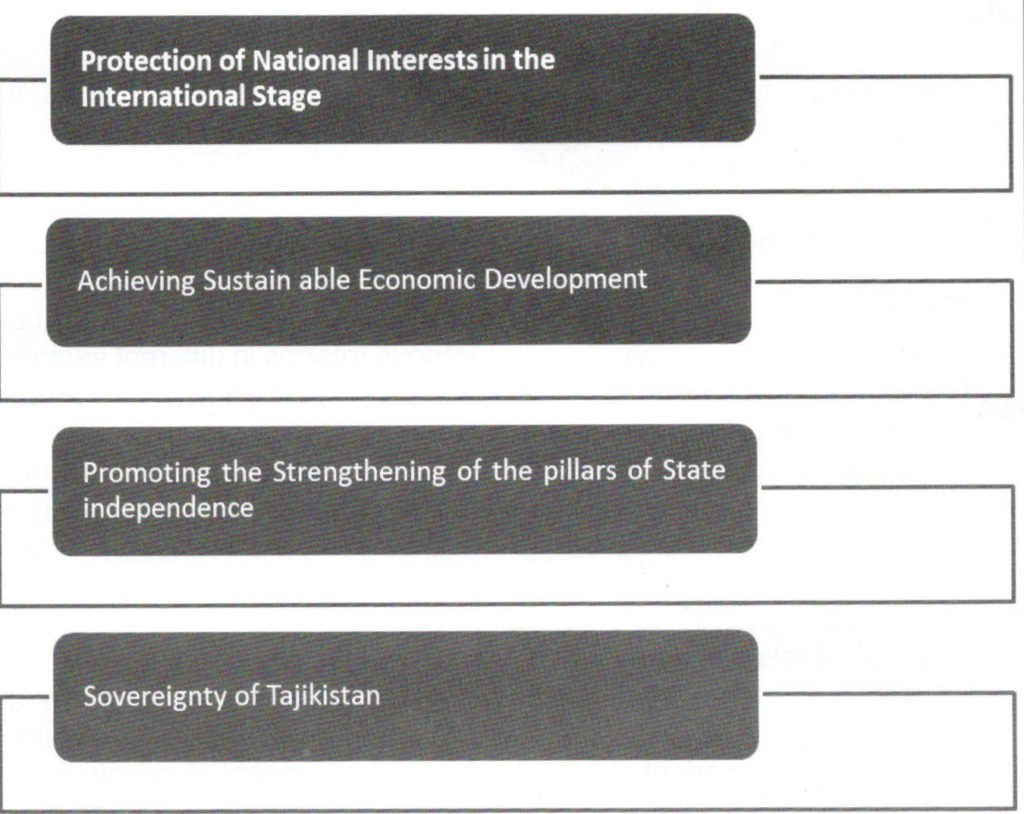
Tajik government desires to become a transit hub due to which construction of a number of roads, bridges and tunnels of national and international importance is being carried out. Moreover, construction and rehabilitation of several important highways of Dushanbe-Chanok, Dushanbe-Tursunzoda, Dushanbe-Kulma, Dushanbe-Saritosh and bridges across the Panj River to connect Tajikistan with Afghanistan are being carried out in the country.
Concluding Remarks
The Republic of Tajikistan is a democratic country. Its leadership is visionary and its people are dynamic. Its economy is resilient which has now outperformed regional countries. Its political system is strong and stable. Its society is vibrant. Its media is responsive which cares about its national causes.
It has successfully introduced various reforms in different sectors of the national economy. It has people’s friendly “public policy” and “administration” too. It has good governance and there is transparency in every sector of the economy. It has great “human capital” which is the real “strategic asset” of Tajikistan. Liberalization of economy, privatization and commercial diplomacy has changed its economic outlook. Moreover, concept of private ownership has pushed its economy in the right direction. Better conditions for entrepreneurship and investment activities are achieved through business and investment friendly policies in the country.
The Law of the Republic of Tajikistan “On Public Property Privatization in the Republic of Tajikistan” was adopted in 1997 which triggered its economy and laid the foundation for formation of a new structure of economy and opened horizons to free market-based economy. Public property privatization also created favorable environment to attract domestic and foreign investments.
The government of Tajikistan adopted a gradual approach towards privatization which saved it from sudden economic collapse and political anarchy. The public property privatization was implemented in two stages based on its goals and objectives. The first stage covered privatization of small enterprises such as trade, public food, consumer services enterprises and vehicles, and the second stage was implemented after renovation of major and medium industrial, transport, communications and construction enterprises. During (1991-2015) some 11,410 small facilities and 1,367 medium and large enterprises were privatized in Tajikistan which fueled its economy which got momentum and achieved its desired goals of socio-economic development, industrialization, generation of new jobs and the last but not the least, energy efficiency and security.
High inflows of FDIs is must for rapid economic growth owning to which Tajik government has introduced various legislations and entrepreneurship provides customs and tax privileges, especially in the priority sectors such as agriculture, extraction of minerals, final processing, energy and so on. The new Tax Code of the Republic of Tajikistan is adopted within the taxation system reform, which reduced the number of taxes from 21 to 10 types. This number was even further reduced to nine types on January 1, 2017. Now Tajikistan is tax heaven for businessmen, investors in the CIS region.
To facilitate the businessmen, the government of Tajikistan reformed the permit system and reduced the number of permits from 650 to 74 during the independence period. The Unified Public Electronic Register of Permits is introduced within these reforms.
With a view to ensuring economic development of the country through improvement of the investment climate and business environment Consultative Council on Improvement of Investment Climate under the Office of the President of the Republic of Tajikistan was established in 2007. The Council is comprised of representatives from governmental agencies, the private sector and development partners.
The Government of Tajikistan has pursued ‘Open Doors’ policy since the beginning of Tajikistan’s independence and has established direct economic and trade relations with more than 120 countries of the world.
To achieve further financial consolidation and expansion in the banking and financial sectors, government has introduced principles of transparency, accountability and effectiveness in the country. Its electronic treasury management system meeting international standards is functional and interactive too. Its current monetary policy mainly focuses on strengthening of the economic and financial sectors, improvement of public welfare and macroeconomic indicators.
To promote networks of SMEs in the country, it adopted the Law “On Microfinance Institutions” promoted the development of microfinance services and entrepreneurship development in the country. While in 1995 the credits invested into the economy amounted to TJS 9.1m, only in 2015 they accounted for TJS 12.5bn with 42 percent of microloans.
Massive industrialization leads towards a sustainable economic development. It creates jobs. It earns crucial revenues. It promotes exports. It achieves economic self-reliance. Tajik industry is equipped with a comprehensive developed framework and technical infrastructure and covers various sectors. It is represented by more than 90 types of production and more than 140 varieties of products covering mineral extraction and processing, coal mining, light and chemical industry, engineering, metal processing, construction materials and food industry.
It attaches a particular importance to acceleration of industrial development and ensuring its sustainability, comprehensive institutional reforms, establishment of private enterprises with attraction of domestic and foreign investment to improve economic efficiency, introduction of technical and technological innovations in industrial production.
Hundreds of small and large production enterprises and jobs have been restored with mobilization of domestic and foreign investment since inception. Now more than 2068 production enterprises are operative, which employ more than 86,400 residents of the country with permanent jobs.
Investments amounting 3.3 billion U.S. dollars in total were made in the country’s industry during (2005-2015), including 2.8 billion U.S. dollars of direct investments and 474.8 million U.S. dollars of other investments. The industrial output reached 12.2 billion Tajik Somoni in 2015.
Tajikistan is rich in non-mineral raw materials for production of construction materials and is ranked as one of the leading countries for these resources in the world. More than 400 deposits containing 30 different types of raw materials (limestone, granite, granodiorite, marble, marble limestone, alabaster, soil, sand and so on) have been discovered and studied in the country.
The construction materials industry is developing through implementation of programs and concepts aimed at doubling production, creating new jobs and thereby reducing poverty rate. While there were only 30 industrial enterprises in this sector in the 90s of the last century, in 2015 their total number reached 450 enterprises employing 8431 people, which is almost three times more than in 1991.
Establishment of scrap metal and ferrous and non-ferrous metal waste processing enterprises within the engineering enterprises started in 2005 and now 33 such enterprises are operative. These enterprises mainly produce building bars, angle beams, metal wires, aluminum pulleys, and other products from metal waste, and market their products in the markets inside and outside the country.
In 2016, the industrial products output accounted for TJS 2.3b and the production of metal No 1 and metal No 2 made 112.5 percent and 143.5 percent accordingly. Production of plumbum dust made 60,000 tons, zinc dust 108,000 tons, copper dust 20,000 tons and antimony 33500 tons accordingly.
There were only 10 chemical and petrochemical enterprises in 1991, while their number reached 45 in 2015, and these companies produced products for TJS 86m.
The coal mining is the most important sector in fuel and energy complex and can play a decisive role in reducing energy constraints and ensuring the country’s energy security in cooperation with domestic and foreign investors. The coal production reached 1.4m tons in 2015 due to the increased demand in coal in various areas.
Tajikistan’s transport sector is vibrant which ensures the country’s connectivity. The actual development of the transport sector in the period of independence began in 1997. At that time only 42 percent of national and only 20 percent of local roads were paved, of which 73 percent was in poor condition, 26 percent of moderate condition and only one percent was in good technical condition.
Rigorous reforms in transport sector have brought innovation and investments too. The government has been increasing public budget funding for road maintenance every year. During (2008-2016) 38 investment projects on construction and reconstruction of highways funded by foreign investments were implemented. Construction and reconstruction of the roads of “Murghob-Kulma”, “Shohon-Zighar, (phases 1, 2 and 3)”, “Shkev-Zighar”, “Dushanbe-Kurghonteppa-Danghara-Kulob”, “Dusti-Panji Poyon, (phases 1 & 2)”, “Dushanbe-Kyrgyz border (phases 1, 2 and 3), “Dushanbe-Chanoq-Uzbekistan border”, “Kurghonteppa-Dusti,(phase 1)”, “Dushanbe-Tursunzode-Uzbekistan border”, “Aini-Panjakent-Uzbekistan border, as well as the tunnels of “Istiqlol”, “Shahriston”, “Dusti”, “Ozodi” and “Khatlon” were completed during this period.
Tajikistan signed bilateral agreements on transportation with 21 international countries and 13 near abroad countries in this period. The country also acceded to 9 international conventions and agreements with a view to improving Tajikistan’s international cooperation on transport, which facilitated international transportation.
In Tajikistan domestic air companies carry out flights in 33 destinations to nine far and near abroad countries and the local aviation authorities provide aeronautical services to 200 domestic and foreign air companies. New modern terminals were constructed in Dushanbe and Khujand international airports and Kulob airport was renovated according to international standards in this period.
More than 90 public investment projects amounting TJS 12bn have been implemented during the last ten years. Currently 63 projects with the total amount of more than TJS 19bn are under implementation. During (2006-2015) TJS 28.3bn of financing with real price, including TJS 9.3bn of fixed assets from public fund was absorbed, and the investments amounted to TJS 48.6bn, including TJS 18.3bn of public investments. Moreover, 8,970,000m2 of housing was constructed, 7,574.500m2of which was financed by population funds and 291,000 m2 was financed by public (state) funds.
Construction of general secondary educational institutions for 184,719 seats, preschool facilities for 2,373 seats, hospitals for 2,953 beds, and out-patient facilities with the capacity of 8389 patient coverage in one shift was completed with the use of funds from all sources.
During 1991-2015 foreign investments amounting USD 8,112.1bn in total, including USD 3,562.4bn of foreign direct investment, which makes 44 percent of the total foreign investments, were channeled into various sectors of the country’s economy.
To achieve its strategic goals, the government of Tajikistan adopted the “National Development Strategy of the Republic of Tajikistan 2030” wherein medium and long-term socio-economic development plans are harmonized and, national objectives are specified and targets and action plans are identified within this Strategy. It specifies the ultimate objective of the country’s transition from agrarian to an industrial country. It provides details of short, medium and long terms plans of Tajikistan which definitely transforms its national economy and will make it a smarter and greener economy in the future.
Social development has had been one of the key priorities of Tajikistan. Since independence, Tajikistan has done a tremendous job in reducing poverty. Between 2000 and early 2009, poverty fell from over 83 to about 47 percent and it decreased further from 37 to 30.3 percent between 2012 and 2016. Since 2012, the poorest regions of the country have made the most progress in poverty reduction.
Being an expert on Tajikistan and Central Asia it is hereby suggested to implement rigorous structural reforms in the country for further reducing the role of the state and enhance role and share of the private sector in the economy through a more favorable business climate. It is also suggested to increase private investment and generate more productive jobs. Modernization and improvement in the efficiency and social inclusiveness of basic public services would be useful in the near future. Greater regional connectivity will increase role and share of construction and service sectors in the country.
Promotion of private sector led growth by improving the investment climate and strengthening competitiveness in key sectors to attract investment and create jobs must be mantra of Tajik government during 2017-2020. Promotion of social inclusion by increasing access to improved social services, including education, health, social assistance, water supply, and sanitation must be foremost priority of its government which would further consolidate societal harmony and process of politicization and democratization in the country. Mainstreaming climate change, improving governance, and narrowing the gender gap must also be pursued.
For attracting more and more inflows of FDIs sincere efforts ought to be carried out to reduce the costs of doing business, strengthen the financial sector, and increase access to finance. The use of the tax e-filing system must be further expanded, and an online permit application system has been further streamlined.
The Agriculture sector employs 64 percent of the country’s population. Participatory public-private model should be followed to modernize this sector. Moreover, performance-based financing should be introduced into the health care structure.




